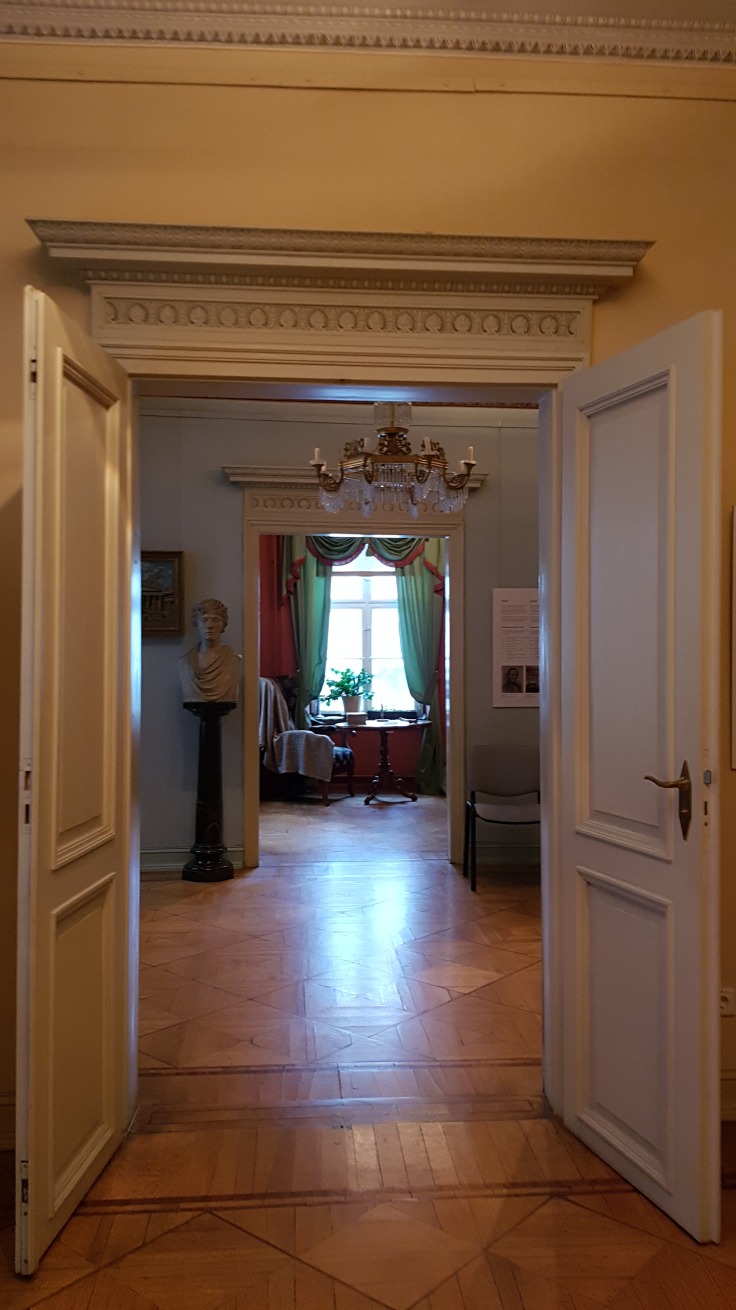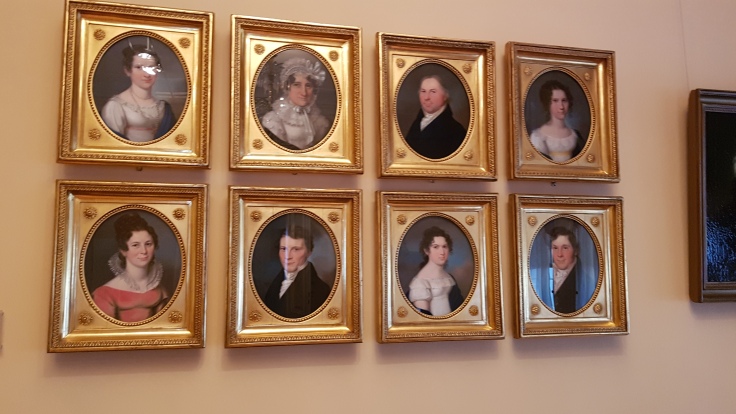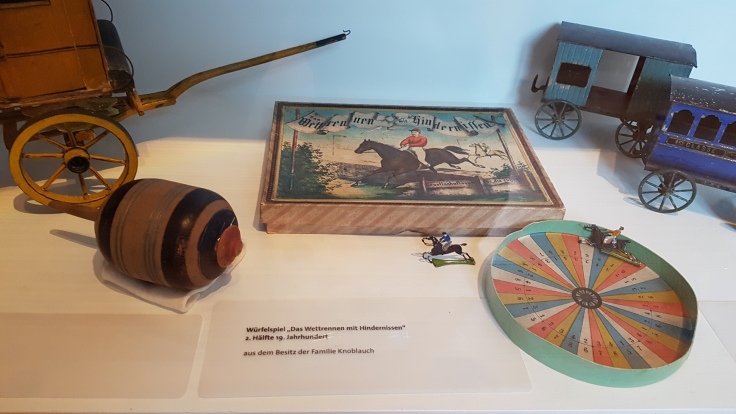The Museum
Today I thought I would share with you one of the highlights of my recent trip to Berlin: The Knoblauch Haus. Located in the historic Nikolaiviertel, the historic heart of Berlin, this free museum lies only a short walk from the banks of the river Spree;
…in close proximity to the church which gave the area its name.

The Knoblauch Haus is one of the few buildings in this area that survived World War II, so it is of particular significance to Berlin’s history.

Although this museum was free, it did not reflect in any way, the quality of the museum’s displays or the artifacts shown there. Much of the items on display were original or relevant to, the family and their various businesses and careers.
As many museums and places of touristic interest in Berlin, this museum provided information printed in English, both on the walls and on laminated cards, which visitors could borrow as they toured the museum. Not only available in German and English, but a few other languages; these laminated cards were extremely helpful in getting around the house and understanding the different elements that make up its architecture, interior design, and history.

The Home
Occupied by the Knoblauch Family for almost 170 years, the building was used both as their family home and, at times, place of business. While living there the family entertained many important Berlin personalities, such as local businessmen, architects, politicians, and scientists.
The story of the house begins with Johann Christian Knoblauch who had the house built between 1759-1761. Johann C. Knoblauch was a needle maker. His considerable fortune was made producing hooks, eyes, and chains for the uniforms of the Prussian army.
From 1806-1835 the house was renovated in a classicist style.
The Biedermeier Period
Today the house provides visitors with the opportunity to experience, first hand, life in the Biedermeier period.
During the era, in central Europe, between the Napoleonic wars (1815) and the 1848 revolution, the middle class increased in number and the arts began to appeal to their humble sensibilities. “Bieder”, means ‘commonplace’, and as you can see from the pictures, the style is quite conservative.

History of the House
The two floors of the house demonstrate the lives of its bourgeois inhabitants. A few of which can be seen below.


In 1789 Carl Friedrich Knoblauch (above), the son of Johann, founded the Textiles and Silk Ribbon manufacturer, which was later taken over by his son.
Another notable member of this family is Eduard Knoblauch. Eduard studied under the guidance of Berlins renowned architect, Karl Friedrich Schinkel and later designed his life masterpiece, the New Synagogue in Oranienburgerstrasse.
Located in the Scheunenviertel , which is north of the city center, this amazing structure, with its impressive gold dome, is beautifully represented in this painting displayed in the museum.
It was completed in 1865 by Emile de Cauwer and is an oil on canvas.
Another notable member of this household was Hermann Knoblauch, who was an experimental physicist at the University of Halle.
Random Interior Design Elements
Curule seat with Intarsia (ca. 1870).
Living Room
Here visitors can see where the family spent most of their time, especially the women and children.
This painting is the wife of the Silk Ribbon merchant, Carl Knoblauch. Henrietta, died of tuberculosis at age 23 in 1821.

Further paintings of the women of the household, found elsewhere in the house…


The table, sofa, and chairs (ca. 1840) were where the family would entertain guests.
The tapestry which is inlaid in both the wooden fireguard and the book on the folding desk, are perfect examples of the needlework which the women of the household would have pursued in their ‘free’ time.
It was obvious from the toys and child’s chair (1st half of the 19th Century), that the children spent a great deal of time here too.
Women of this time would have also spent a great deal of their time, attending to their correspondence at this beautiful desk.
Entrée
This small room served to connect the living room and library.
Library
Bedroom
Blue Room
The Study

The Kitchen
Random Items Around the Home
What They Wore


Unique Modes of Transport
Toys

Knick Knacks
Instrument

Tools

Furniture
The Neighbourhood
Following my tour of the house, a visit to the surrounding neighborhood was essential.
Strolling the cobblestoned streets of the Nikolaiviertel, I discovered many a place to fill my tummy with yummy delicacies. The three photos below are from the previous day.
I ended my tour, with a visit to a Dutch bakery and café, which sold dutch items of interest as well as food.
It was truly a feast for the imagination.
I could have whiled away the afternoon in its comfortable atmosphere, soaking up all the inspiration Holland offers, with its cultural background and handmade crafts.
I wish I could have taken these home with me.
Instead, I opted for a few pieces of cake to take back to the apartment, to be enjoyed with friends.

So delicious!
There was plenty to see in this area, lots of lovely little shops and boutiques, which I would have liked to explore more.
This was one of the shops I did make it into for a bit of souvenir shopping, pre museum visit.
But my heart was pulling me here, oh well, next time.
Despite the fact that I visited this area on two occasions, those visits were simply not enough to soak up all of the history and culture that this area offered.

I can definitely tell you, that Berlin, I will be back! And next time, I will not only be carrying my most handy possession from this trip….

but also a hungry appetite for all that Berlin has to offer.
P.S. Don’t worry- those are my PJs (seen above) and no, I didn’t go walking around Berlin in them.
P.P.S. Despite the fact that I spent most of the morning at the Knoblauch House and in the Nikolaiviertel, absorbing all it had to offer, I can see that another visit is much needed. Ideally, I would like to go back with my friend who is not only well informed of German history but also the decorative arts. My research for this post will, of course, improve my understanding of the families background and the beautiful design elements that went into its build and furnishing.
So dear reader, you made it this far, how about a comment to let me know how you found the post? I would love to hear from you.
Jodie























































































I loved this tour, and was very much interested in the colors of all the rooms–such bright and deep colors makes me want to get out the paint can over here. We plan to visit Berlin next year, so I’ll bookmark this post for ideas of where to go while my husband is working. Thanks for this!
LikeLiked by 1 person
No problem Elizabeth. I’m glad you liked it. It was a very inspiring place!! I love seeing other people’s homes, old or new, museum or not. Hopefully more to come!!
LikeLike
Thank you for the beautiful photographs and narrations. I found this because I was looking up my mother’s business (long since defunct.) My brothers and I are descendants of the family that lived in the KnoblauchHaus. Carl (Charles), the son of Eduard the architect, moved to New York, married twice, the second time to an American woman, and fathered a son by her, my grandfather. Charles died 18 months after he married her, when his son was three months old.
LikeLiked by 1 person